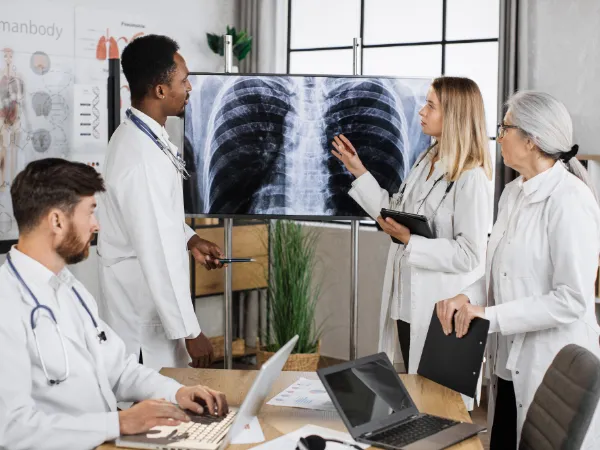Overview on What Disease Affects Lungs?
The lungs are essential organs that help us breathe by taking in oxygen and expelling carbon dioxide. But like any other part of the body, the lungs can be affected by various diseases. This blog will explore “what disease affects lungs,” looking at different types of lung diseases, their symptoms, causes, and how they can be treated.
How Many Types of Lung Disease?

Lung diseases can be classified into several groups depending on which part of the lungs they affect. The main categories are:
- Obstructive Lung Diseases: These diseases make it hard to breathe out. Examples include chronic obstructive pulmonary disease (COPD) and asthma.
- Restrictive Lung Diseases: These conditions prevent the lungs from expanding fully. Examples include pulmonary fibrosis and sarcoidosis.
- Infectious Lung Diseases: Infections that affect the lungs, such as pneumonia and tuberculosis.
- Lung Cancer: This is a serious condition where malignant cells grow in the lungs NIH.
- Pulmonary Vascular Diseases: These diseases affect the blood vessels in the lungs, like pulmonary hypertension.
These categories help us understand the various types of lung diseases and how they impact our breathing.
Deadly Lung Diseases
Some lung diseases can be particularly deadly. For instance, lung cancer is one of the leading causes of cancer-related deaths worldwide. Another deadly lung disease is COPD, which includes chronic bronchitis and emphysema and can cause long-term breathing problems. Additionally, pulmonary embolism, where blood clots block the arteries in the lungs, can be fatal if not treated promptly.
What Are 10 Different Lung Diseases?

There are many different lung diseases, and here are ten of the most well-known ones:
- Asthma: A condition that causes the airways to narrow and swell, making it hard to breathe.
- COPD: A group of diseases, including chronic bronchitis and emphysema, that block airflow.
- Lung Cancer: The growth of abnormal cells in the lungs NIH.
- Pneumonia: An infection that inflames the air sacs in one or both lungs CDC.
- Tuberculosis: A bacterial infection that mainly affects the lungs.
- Pulmonary Fibrosis: A condition where the lung tissue becomes scarred and stiff.
- Pulmonary Hypertension: High blood pressure in the arteries of the lungs.
- Cystic Fibrosis: A genetic disorder that causes severe damage to the lungs and digestive system.
- Bronchitis: Inflammation of the bronchial tubes, which carry air to the lungs.
- Pleural Effusion: A condition where excess fluid builds up around the lungs.
These diseases can vary greatly in how they affect the lungs and overall health.
What Are the 7 Most Common Lung Diseases?

If you’re wondering “what are the 7 most common lung diseases,” here they are:
- Asthma
- COPD
- Lung Cancer
- Pneumonia
- Tuberculosis
- Pulmonary Embolism
- Pulmonary Fibrosis
These diseases are quite common and can have significant impacts on daily life and health.
Rare Lung Disease List
There are also rare lung diseases that you might not have heard of. Here’s a list of some rare lung conditions:
- Pulmonary Alveolar Proteinosis: A disease where proteins accumulate in the air sacs of the lungs.
- Lymphangioleiomyomatosis (LAM): A rare disease that affects women, leading to lung destruction.
- Eosinophilic Pneumonia: An inflammation of the lungs caused by an increase in a type of white blood cell called eosinophils.
- Pulmonary Arterial Hypertension (PAH): A specific type of high blood pressure in the lungs.
- Chronic Eosinophilic Pneumonia: A long-term condition characterized by eosinophil accumulation in the lungs.
These diseases are not commonly seen but can still cause serious health issues.
Symptoms of Lung Disease in Females

Lung diseases can present differently in females. Common symptoms of lung disease in females include:
- Shortness of breath: Difficulty breathing, especially during activities.
- Persistent cough: A long-lasting cough that doesn’t go away CDC.
- Wheezing: A whistling sound when breathing.
- Chest pain: Pain or discomfort in the chest area.
- Fatigue: Unusual tiredness or lack of energy.
- Frequent respiratory infections: Increased risk of infections like pneumonia.
It’s important for women to be aware of these symptoms, as they can sometimes be overlooked.
Causes of Lung Disease

There are several causes of lung disease, including:
- Smoking: The most significant risk factor for many lung diseases, including lung cancer and COPD.
- Air pollution: Exposure to pollutants can damage the lungs over time.
- Genetics: Some lung diseases, like cystic fibrosis, are inherited by NIH.
- Infections: Bacteria, viruses, and fungi can lead to lung infections.
- Occupational hazards: Exposure to harmful substances at work, like asbestos or silica, can cause lung disease.
Knowing these causes can help in preventing and managing lung diseases.
Lung Diseases List
The lung diseases list includes a variety of conditions, such as:
- Asthma
- COPD
- Lung Cancer
- Pneumonia
- Tuberculosis
- Pulmonary Fibrosis
- Pulmonary Hypertension
- Cystic Fibrosis
- Bronchitis
- Pleural Effusion
This list shows the wide range of diseases that can affect the lungs, each with its own challenges and treatment options.
Chest Diseases List

Besides lung diseases, the chest diseases list includes conditions that affect other parts of the chest, such as:
- Heart diseases: Conditions like heart failure can impact lung function.
- Pleurisy: Inflammation of the tissues around the lungs.
- Costochondritis: Inflammation of the cartilage connecting the ribs to the breastbone.
- Pericarditis: Inflammation of the sac around the heart.
These conditions can sometimes mimic lung disease symptoms, making diagnosis tricky.
Sum up,
Understanding “what disease affects lungs” is crucial for recognizing the signs and symptoms of these conditions, knowing their causes, and seeking proper treatment. There are many types of lung diseases, ranging from common conditions like asthma and COPD to rare disorders like pulmonary alveolar proteinosis. Being aware of the symptoms of lung disease in females and the causes of lung disease can help in early detection and prevention. Whether dealing with deadly lung diseases or conditions from the chest diseases list, it’s important to prioritize lung health and seek medical advice if you experience any symptoms.
Frequently Asked Questions
Q1. What are the early signs of serious lung disease?
Ans – Early signs include a long-lasting cough, trouble breathing, and persistent fatigue
Q2. How does smoking contribute to lung disease?
Ans – Smoking harms lung tissues, increasing the risk of diseases like lung cancer and COPD.
Q3. Can lung diseases be prevented?
Ans – Yes, by avoiding smoking, reducing exposure to pollutants, and getting regular check-ups.
Q4. Are there specific lung diseases that mainly affect women?
Ans – Yes, diseases like lymphangioleiomyomatosis (LAM) are more common in women.
Q5. How does genetics influence lung diseases?
Ans – Genetic factors can increase the risk of certain lung diseases, such as cystic fibrosis.
Q6. How do environmental factors lead to lung diseases?
Ans – Pollution and allergens can damage lung tissues and worsen conditions like asthma.
Q7. What treatments are available for rare lung diseases?
Ans – Treatments vary and may include medication, lifestyle changes, or surgery.







